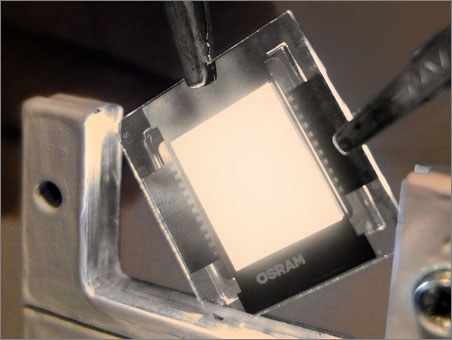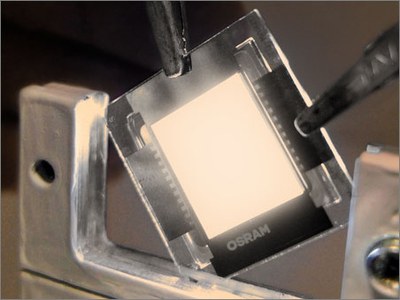OSRAM OLED Achieves High Levels of Efficiency and Lifetime
After only two years of development, OSRAM has achieved record values in the laboratory for organic light emitting diodes in warm white, with an efficiency of 46 lm/W and a brightness of 1000 cd/m² for more than 5000 hours.
For the first time it has been possible to improve two crucial OLED characteristics simultaneously as up to now these have generally changed in inverse proportion to one another. Higher efficiency used to mean shorter life, and vice versa.
Dr. Karsten Heuser, Director of OLED Lighting Technology at OSRAM Opto Semiconductors is pleased with the excellent intermediate results. “Our development team has reached a real milestone for warm white OLEDs with an efficiency of 46 lm/W (CIE of 0.46/0.42 measured in the integrating sphere) and a life of more than 5000 hours. With this significant increase in efficiency and life, OLED flat light sources are approaching the values of conventional lighting solutions and are therefore becoming attractive for a wide variety of applications.”
The color rendering index (CRI) of the almost 100 cm² large prototype is 80. By March 2009, development should be so far advanced that a demonstrator for an energy-saving OLED flat light module comprising several tiles will be able to deliver an overall luminous flux of 500 lm from a power consumption of less than 10 W.
OLEDs Will Enhance the Premium Segment with Atmospheric Light:
OLED light sources will be particularly welcome where their special properties as flat light sources offering high quality of light make a real impression, for example in illuminated wall coverings, atmospheric canopies of light and light partitions. With their pleasant diffused light, the color of which can be individually controlled, OLEDs will enhance the premium design segment, for example as light tiles that can be attached to any surface. For widespread applications it will be necessary to produce efficient OLEDs in large numbers at reasonably low cost – an essential objective of the research project.
Joint Project Involving OSRAM, Siemens CT, Fraunhofer Gesellschaft and Universities:
The remarkable results were achieved as part of the “500 lm Multi-OLED Module” project under the OPAL research consortium. This project is focusing on the optimization of the layer system comprising small molecules, in which the layers are produced by means of vacuum evaporation. In addition to OSRAM, this project involves Siemens Corporate Technology, the universities in Darmstadt, Braunschweig and Augsburg and the IPMS Dresden.
Background Information on the OPAL Research Project:
The German Federal Ministry for Education and Research (BMBF) launched a broad-based initiative to strengthen the OLED position in Germany. The BMBF research project was given the name OPAL (Organic Phosphoresce Diodes for Applications on the Lighting Market). Its purpose is to create a research platform to develop the underlying technology blocks for subsequent series production of OLEDs and their widespread marketing in the future. As the coordinator, OSRAM is working at full pace on the development of high-efficiency OLED light sources that consume little energy.


